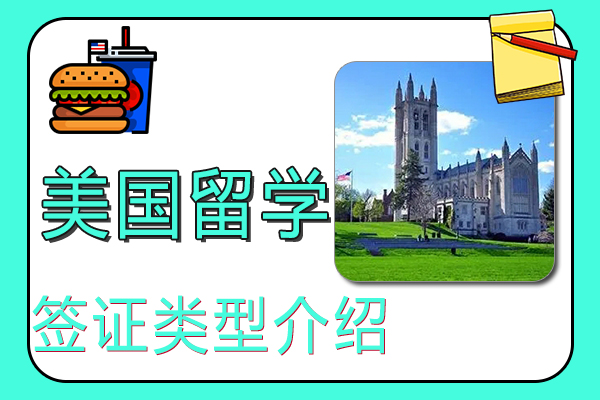Although there are many countries to study in, most people still have the United States as their main goal. The following is a list of information aboutU.S. Student VisaType introduction, US study visa,U.S. Student Visa Passage, ,U.S. Student Visa Security Deposit, ,How to apply for a U.S. student visa, ,Agent for U.S. Student VisaThe problem.

Introduction to U.S. Student Visa Types
Introduction to U.S. Student Visa Types
Type 1: F visa
This type of U.S. student visa is for international students who intend to pursue an academic degree at an accredited U.S. college or university, or to study English at a university or institution that provides English language enhancement. There are three types of F visas:
▪F-1 visa is for full-time students
▪The F-2 visa is for the dependents (spouse and unmarried children under the age of 21) of an F-1 visa holder, including spouses of the same sex.
▪The F-3 visa is for "border commuters" - students who live in Mexico and Canada in their country of origin, but attend school in the United States part-time or full-time.
Students with an F-1 visa may work on campus for 20 hours or less per week. Students who wish to work longer hours and work off-campus must obtain prior approval from the United States Citizenship and Immigration Services (USCIS) - they may also be authorized to work for Curricular Practical Training (CPT) and Optional Practical Training (OPT) for a full 12-month period, excluding the 90 days of unemployment.
Type 2: M visa
This type of US student visa is for international students who want to participate in non-academic, vocational studies or obtain training at an institution in the United States. There are three types of M visas:
▪M-1 visa is for students who are going to study vocational or non-academic courses
▪M-2 visa is for family members of M-1 visa holders (same as F-2 visa)
▪The M-3 visa is for "border commuters" and, like the F-3 visa, is for vocational or non-academic study.
Students on an M-1 visa are admitted to the U.S. for a fixed period of time - the length of their training program plus any optional practical training. They cannot stay in the U.S. for more than one year, except for medical extensions. M-1 visa holders are not allowed to work on or off campus during their studies, and cannot change status to an F-1 visa.
The third type: J visa
This last type of US student visa is for international exchange visitors who are participating in a US program to promote cultural exchange. Regardless of whether they are receiving medical, business, or other training, all applicants must meet the eligibility criteria for the program in question and be sponsored by a private sector or government program. J visa holders usually stay in the US for only a short period of time, perhaps 1 or 2 semesters. There are two types of J visas:
▪J-1 visa is for exchange students in related exchange programs
▪J-2 visa is for family members of J-1 visa holders (same as F-2 visa)
J-1 visa holders who are part of a government-sponsored exchange program will be subject to a two-year return-to-country residency requirement to pursue graduate medical education, training, or training that is included on the exchange visitor skills list (i.e., the J-1 visa holder's country of origin deems their expertise or skills necessary for the country's development). These requirements mean that J-1 visa holders will need to return to their country of origin at least two years after completing their exchange visitor program.
Further reading: Language requirements for studying in the United States at different stages
1. High school
Common language scores for US high school study abroad applications include SLEP, TOEFL Junior, and TOEFL. Please note that TOEFL Junior can be used as an admission application for 8th grade students, but TOEFL scores are still required for 9th and 10th grade students.
Tops generally recommends SLEP scores of 55 or above and TOEFL scores of 80 or above.
2. Undergraduate
The language requirements for undergraduate studies in the United States are relatively high. The TOEFL score must be at least 79 or the IELTS score must be above 6.0. Generally speaking:
Apply to the top 30 universities: TOEFL at least 100 points, IELTS at least 7 points
Apply to 50-30 universities: TOEFL 90 or above, IELTS 6.5 or above
Applying to 100-50 universities: TOEFL score must be above 79 points, IELTS score must be above 6 points.
It should be noted that quite a few American undergraduate colleges can issue conditional admission letters to students. That is, students can take language courses for a period of time before the start of undergraduate studies and then study the course. As for the length of the language course, it depends on the student's learning situation.
3. Postgraduate stage
For most majors, the minimum score for schools with low TOEFL requirements is generally 79 or 80 points. Most schools with high requirements have a minimum score of 100 points, and a few schools have score requirements higher than 100 points, such as Columbia University's media major. If you can get more than 100, the basic choice of school will not be hindered by TOEFL. If other conditions are good, the application effect will be better. Liberal arts majors generally have higher TOEFL requirements, such as media and other majors. Not only the top 50 schools, but also many schools between 50 and 100 require a TOEFL score of 100.
IELTS is also acceptable. In the top 50 universities in the United States, both undergraduates and postgraduates have very high requirements for IELTS scores, and IELTS generally requires at least 7 points. If you want to apply for the top 50 universities for business school (BNP Paribas) and law school (laws school), as well as postgraduates in media, you need to get at least 7.5 points in IELTS. To apply for ordinary universities in the United States, you need at least 6.0 points in IELTS and 6.5 points in postgraduates. Although IELTS has been recognized by a large number of American universities, the IELTS scores required by American universities are relatively demanding, generally above 7.0 points, and some even require 7.5 points.
Further reading: How to apply to study in the United States
1. Go to university after high school
Parents need to make reasonable plans for their children's education as early as possible, combining students' interests and strengths with parents' expectations.
Once you have determined the goal of studying abroad, try to start preparing in junior high school or even elementary school, because the development of students' qualities in all aspects, especially language ability, is not a one-day job. Parents should focus on cultivating their children's self-care ability, learning ability and especially language ability when they are in elementary school. They should enter the preparation state from the first year of junior high school, starting with language and grades in various subjects, especially strengthening English listening, speaking, reading and writing skills.
2. Apply directly
Students who choose this method of applying to American universities need to take various standardized tests, mainly including SAT, TOEFL or IELTS. All American universities accept this application method. American universities want to recruit well-rounded students, so students who want to use the conventional application method should not only focus on academic performance, but also participate in various social activities and pay attention to development issues.
3. Transfer
American universities accept transfer students and admit a certain number of foreign transfer students every year. Therefore, current domestic college students can enter American universities through transfer, and transfer accordingly. Students only need to complete other credits required by the transferred university to graduate, and can obtain a degree from the transferred university upon graduation. Suitable for domestic college students/junior college students.
4. Conditional Admission
Some American universities provide conditional admission without SAT, TOEFL or IELTS for students who do not have standardized test scores; the school issues two admission letters: one is for the language area of the school, and the other is for the school's undergraduate conditional admission, so it is also called "double admission."
The "conditional" here means that after admission, students must first study in a language learning area. After passing the language test, they can directly enter undergraduate studies without applying separately. Conditional admission provides students with a convenient channel to apply for American universities, and they can also apply for many scholarships. Compared with direct application, students who choose this path can first go to the United States and learn the language in an American English environment.
5. Community College
"2 years of community college + 2 years of four-year university" means that when a student is admitted to a community college, the community college will also issue a conditional admission notice from a four-year comprehensive university based on his or her personal choice; "conditional" here means that the student first completes the first two years of study (associate degree) at the community college, and then transfers to a four-year university to complete the last two years of study (bachelor's degree), and the undergraduate diploma is issued by the four-year university. The four-year comprehensive university to which the student transfers is often...
Introduction to U.S. Student Visa Types
Summary of the types of US study visas
After understanding the types of U.S. study visas, you will also need to prepare an online tool to bypass the firewall and return to China when studying in the United States.For many Chinese who go to the US to study and work, they still like to watch some Chinese TV series and programs in China, and they are more accustomed to use some domestic native apps to listen to music, watch videos, play games and so on. However, due to copyright reasons, most of the popular programs are only allowed to be accessed by mainland IPs. In such a big background, theBack to China via the InternetQuickFox is the best choice for overseas Chinese to return to China, access domestic websites or applications, enjoy domestic music and video resources, and solve copyright and regional restrictions with one click.














